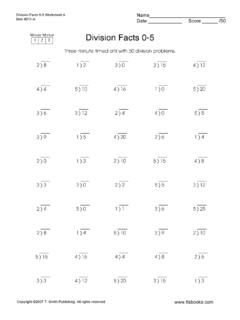Transcription of LM2937 2.5-V and 3.3-V 400-mA and 500-mA Voltage ...
1 ProductFolderSample &BuyTechnicalDocumentsTools &SoftwareSupport & , FEBRUARY1998 and 400-mAand 500-mAVoltageRegulators1 Features3 DescriptionThe positivevoltage1 OperatingInputVoltageRange: to 26 Vregulatorscapableof supplyingup to 500 mA of load FullySpecifiedfor OperationOver 40 C to 125 idealfor convertinga OutputCurrentin Excessof 500 mA (400mA forcommon5-V logicsupply,or higherinputsupplySOT-223package) Voltage , to the (VLSI)ASIC sand OutputTrimmedfor 5% minimizethe quiescentcurrentto WideOutputCapacitorESRR ange, up totypicallyonly10 mA with a full 500-mAloadcurrent5 whenthe inputto outputvoltagedifferentialis greater InternalShortCircuitand ThermalOverloadthan5 LM2937requiresan outputbypasscapacitorfor with mostregulatorsutilizinga PNPpasstransistor,the ESRof this capacitorremainsa critical 60-VInputTransientProtectiondesignparame ter,but the LM2937is stablefor Automotiveall ESRratingsless than5.
2 Thisallowsthe use oflow ESRchip capacitors. IndustrialControl Point-of-LoadRegulationTheregulatorsarea lsosuitedfor automotiveapplications,withbuiltin protectionfromreverseSimplifiedSchematic batteryconnections,two-batteryjumpsand up to +60V/ 50 V shortcircuitand thermalshutdownprotectionare also built (1)PARTPACKAGEBODYSIZE(NOM)NUMBER* Requiredif the regulatoris locatedmorethan3TO-220(3) x powersupplyfilter (4) x mm** Requiredfor at least10 FTO-263(3) x (overfull expectedoperatingtemperaturerange)(1) For all availablepackages,see the orderableaddendumatand locatedas closeas possibleto the end of the equivalentseriesresistance,ESR,of thiscapacitormay be as high as 3.
3 1An IMPORTANTNOTICEat the end of this datasheetaddressesavailability,warranty, changes,use in safety-criticalapplications,intellectual propertymattersand , FEBRUARY1998 Applicationand Pin Configurationand Deviceand Mechanical,Packaging,and RevisionHistoryChangesfromRevisionE (April2013)to RevisionFPage AddedDeviceInformationandHandlingRatingt ables,FeatureDescription,DeviceFunctiona lModes,ApplicationandImplementation,Powe rSupplyRecommendations,Layout,DeviceandD ocumentationSupport, andMechanical,Packaging,andOrderableInfo rmationsections;updatedThermalInformatio n; 1998 2014, (TAB) , FEBRUARY1998 REVISEDNOVEMBER20145 Pin Configurationand Functions3 Pins4 PinsTO-220(NDE)SOT-223(DCY)FrontViewTop View3 PinsDDPAK/TO-263(KTT)Top ViewPin FunctionsPINI/ODESCRIPTIONNAMENDEKTTDCYI NPUT111 IUnregulatedvoltageinputGND222 pin requiresan outputcapacitorto theDetailedDesignProceduresectionfor TABto a largecopperareatoremoveheatfromthe TABis internallyconnectedto devicepinGNDTABTAB4 2 (GND).
4 Connectthe TABto GNDor not connecttheTABto any potentialotherthanGNDat devicepin 1998 2014,TexasInstrumentsIncorporatedSubmitD ocumentationFeedback3 , FEBRUARY1998 (unlessotherwisenoted)(1)(2)MINMAXUNITC ontinuous26 Inputvoltage(VIN)VTransient(t 100 ms)60 Internalpowerdissipation(3)Internallylim ited(1)StressesbeyondthoselistedunderAbs oluteMaximumRatingsmay causepermanentdamageto the stressratingsonly,whichdo not implyfunctionaloperationof the deviceat theseor any otherconditionsbeyondthoseindicatedunder RecommendedOperatingConditions. Exposureto absolute-maximum-ratedconditionsfor extendedperiodsmay affectdevicereliability.
5 (2)If Military/Aerospacespecifieddevicesare required,pleasecontactthe TexasInstrumentsSalesOffice/Distributors for availabilityandspecifications.(3)The maximumallowablepowerdissipationat any ambienttemperatureis PMAX= (125 C TA)/R JA, where125 C is the maximumjunctiontemperaturefor operation,TAis the ambienttemperature,and R JAis the thisdissipationis exceeded,the die temperaturewill rise above125 C and the electricalspecificationsdo not the die temperaturerisesabove150 C, the LM2937will go into 65150 CHumanbodymodel(HBM),per ANSI/ESDA/JEDECJS-001,all 20002000V(ESD)ElectrostaticdischargeVpin s(1)(1)JEDEC documentJEP155statesthat 500-VHBM allowssafe manufacturingwith a (unlessotherwisenoted)(1)MINNOMMAXUNITLM 2937ET(NDE),LM2937ES(KTT)
6 40125 Junctiontemperature(TJ)(2) CLM2937 IMP(DCY) 4085 Inputvoltage(VIN) (1)StressesbeyondthoselistedunderAbsolut eMaximumRatingsmay causepermanentdamageto the stressratingsonly,whichdo not implyfunctionaloperationof the deviceat theseor any otherconditionsbeyondthoseindicatedunder RecommendedOperatingConditions. Exposureto absolute-maximum-ratedconditionsfor extendedperiodsmay affectdevicereliability.(2)The maximumallowablepowerdissipationat any ambienttemperatureis PMAX= (125 C TA)/R JA, where125 C is the maximumjunctiontemperaturefor operation,TAis the ambienttemperature,and R JAis the thisdissipationis exceeded,the die temperaturewill rise above125 C and the electricalspecificationsdo not the die temperaturerisesabove150 C, the LM2937will go into (1)NDE(2)KTTDCYUNIT3 PINS3 PINS4 PINSR JC(top)Junction-to-case(top) C/W JC(bot)Junction-to-case(bottom) (1)For moreinformationabouttraditionaland new thermalmetrics,see theICPackageThermalMetricsapplicationrep ort,SPRA953.
7 (2)Thermalinformationfor the TO-220packageis for a free-standingpackageverticallymountedin the middleof a PCBwhichis compliantto the JEDECHIGH-K2s2p(JESD51-7) additionalheatsink is 1998 2014, , FEBRUARY1998 VNOM+ 5 V, IOUTmax= 500 mA for the TO-220and DDPAK/TO-263packages,IOUTmax= 400 mA for the SOT-223package,COUT= 10 F otherspecificationsare for TA= TJ= 25 C, unlessotherwisespecifiedin the TestConditions.(1)OUTPUTVOLTAGE(VOUT) VUNITPARAMETERTESTCONDITIONSMINTYPMAXMIN TYPMAX5 mA IOUT mA IOUT C TA 125 VIN 26 V, 5 mALine regulation(2) VIN 26 V,IOUT= 5 mA2533-40 C TA 125 C5 mA IOUT mA IOUT IOUTmax2533-40 C TA 125 C7V VIN 26 V, IOUT= 5 mA22mA7V VIN 26 V, IOUT= 5 mA1010-40 C TA 125 CVIN= (VOUT+ 5V), IOUT= IOUTmax1010 QuiescentcurrentmAVIN= (VOUT+ 5V)
8 , IOUT= IOUTmax2020-40 C TA 125 CVIN= 5 V, IOUT= IOUTmax6610066100mAVIN= 5 V, IOUT= IOUTmax125125 40 C TA 125 C10 Hz 100 kHz,Outputnoisevoltage7599 VrmsIOUT= 5 40 C TA 125 < 100 ms, RL= 100 6060 Vvoltage-40 C TA 125 Ctf< 100 ms, RL= 100 7575 VMaximum 40 C TA 125 C26operationalinput26 VvoltageReverseDC inputVOUT V, RL= 100 15 15voltage-40 C TA 125 CVVOUT V, RL= 100 30 30 Reversetransienttr< 1 ms, RL= 100 5050inputvoltage-40 C TA 125 CVtr< 1 ms, RL= 100 75 75(1)Typicalsare at TJ= 25 C and representthe mostlikelyparametricnorm.(2)The minimuminputvoltagerequiredfor properbiasingof theseregulatorsis Belowthis levelthe outputswill fall out effectis not the normaldropoutcharacteristicwherethe outputfalls out of regulationdue to the a valuefor worstcaseeffectiveinputto outputdropoutvoltageis requiredin a specification,the maximumfor the V maximumfor the 1998 2014,TexasInstrumentsIncorporatedSubmitD ocumentationFeedback5 , FEBRUARY1998 OutputVoltagevs Temperature( V)Figure2.
9 OutputVoltagevs Temperature( V)Figure3. QuiescentCurrentvs OutputCurrent( V)Figure4. QuiescentCurrentvs OutputCurrent( V)Figure5. QuiescentCurrentvs InputVoltage( V)Figure6. QuiescentCurrentvs InputVoltage( V)6 SubmitDocumentationFeedbackCopyright 1998 2014, , FEBRUARY1998 REVISEDNOVEMBER2014 TypicalCharacteristics(continued)Figure8 . LoadTransientResponseFigure7. LineTransientResponseFigure9. RippleRejectionFigure10. OutputImpedanceFigure11. LowVoltageBehavior( V)Figure12. LowVoltageBehavior( V)Copyright 1998 2014,TexasInstrumentsIncorporatedSubmitD ocumentationFeedback7 , FEBRUARY1998 (continued)Figure14.
10 OutputCapacitorESRF igure13. OutputAt VoltageExtremesFigure15. PeakOutputCurrentFigure16. MaximumPowerDissipation(TO-220)Figure17. MaximumPowerDissipation(DDPAK/TO-263)(1) (1)The maximumallowablepowerdissipationat any ambienttemperatureis PMAX= (125 C TA)/R JA, where125 C is the maximumjunctiontemperaturefor operation,TAis the ambienttemperature,and R JAis the thisdissipationis exceeded,the die temperaturewill rise above125 C and the electricalspecificationsdo not the die temperaturerisesabove150 C, the regulatorwill go into junction-to-ambientthermalresistanceR JAis 65 C/W,for the TO-220 package,73 C/Wfor the DDPAK/TO-263package,and 174 C/Wfor the a heatsink,R JAis thesum of the devicejunction-to-casethermalresistanceR JCof 3 C/Wand the theDDPAK/TO-263or SOT-223packagesare used.
















